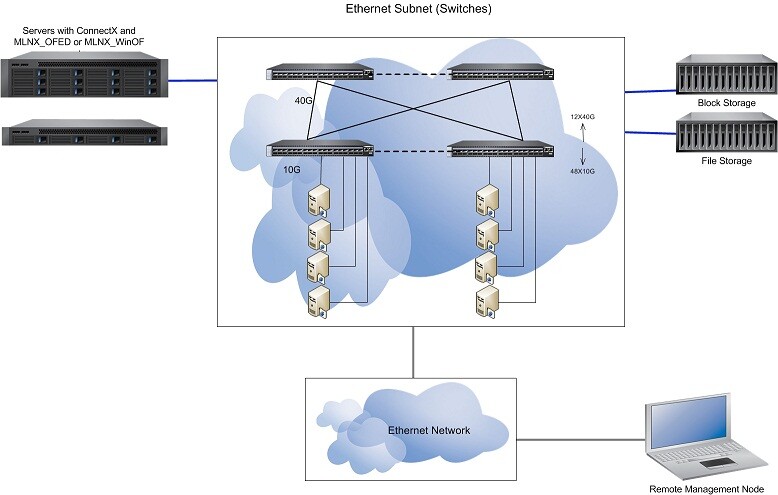Overview
These pages are intended for network administrators who are responsible for configuring and managing NVIDIA’s switch platforms.
The following table lists the documents referenced in this User Manual.
|
Document Name |
Description |
|
System Hardware User Manual |
This document contains hardware descriptions, LED assignments, and hardware specifications, among other things |
|
Switch Product Release Notes |
Please look up the relevant switch system/series Release Notes file |
|
This reference architecture provides general information concerning NVIDIA L2 and L3 Virtual Modular Switch (VMS) configuration and design |
|
|
Community |
Provides Ethernet Switch Solutions |
|
Term |
Description |
|
AAA |
Authentication, Authorization, and Accounting:
|
|
ARP |
Address Resolution Protocol. A protocol that translates IP addresses into MAC addresses for communication over a local area network (LAN). |
|
CLI |
Command Line Interface. A user interface in which you type commands at the prompt. |
|
DCB |
Data Center Bridging |
|
DCBX |
Should be Data Center Bridging eXchange—an extension of Link Layer Data Protocol to discover DCB compliant peers and exchange configuration information |
|
DHCP |
The Dynamic Host Configuration Protocol (DHCP) is an automatic configuration protocol used on IP networks. |
|
DNS |
Domain Name System. A hierarchical naming system for devices in a computer network. |
|
ECN |
Explicit Congestion Notification |
|
ETS |
Enhanced Transmission Selection provides a common management framework for assignment of bandwidth to traffic classes. |
|
FTP/TFTP/sFTP |
File Transfer Protocol (FTP) is a standard network protocol used to transfer files from one host to another over a TCP-based network, such as the Internet. |
|
Gateway |
A network node that interfaces with both InfiniBand and Ethernet, using different network protocols. |
|
HA |
High Availability. A system design protocol that provides redundancy of system components, thus enables overcoming single or multiple failures in minimal downtime. |
|
Host |
A computer platform executing an Operating System which may control one or more network adapters |
|
LACP |
Link Aggregation Control Protocol (LACP) provides a method to control the bundling of several physical ports together to form a single logical channel. LACP allows a network device to negotiate an automatic bundling of links by sending LACP packets to the peer (directly connected device that also implements LACP). |
|
LDAP |
The Lightweight Directory Access Protocol is an industry standard application protocol for accessing and maintaining distributed directory information services over an IP network. |
|
LLDP |
Link Layer Discovery Protocol. A vendor neutral link layer protocol used by network devices to advertise their identify, capabilities and for neighbor discovery. |
|
MAC |
A Media Access Control address (MAC address) is a unique identifier assigned to network interfaces for communications on the physical network segment. MAC addresses are used for numerous network technologies and most IEEE 802 network technologies including Ethernet. |
|
MTU |
Maximum Transfer Unit. The maximum size of a packet payload (not including headers) that can be sent /received from a port. |
|
Network Adapter |
A hardware device that allows for communication between computers in a network. |
|
NTP |
Network Time Protocol. A protocol for synchronizing computer clocks in a network. |
|
PFC/FC |
Priority Based Flow Control applies pause functionality to traffic classes OR classes of service on the Ethernet link. |
|
PTP IEEE-1588 |
Precision Time Protocol. A high-accuracy time transfer protocol for synchronizing computer clocks in a network. |
|
RADIUS |
Remote Authentication Dial In User Service. A networking protocol that enables AAA centralized management for computers to connect and use a network service. |
|
RDMA |
Remote Direct Memory Access. Accessing memory in a remote side without involvement of the remote CPU. |
|
RoCE |
RDMA over Converged Ethernet. A network protocol that leverages Remote Direct Memory Access (RDMA) capabilities to accelerate communications between applications hosted on clusters of servers and storage arrays. |
|
RSTP |
Rapid Spanning Tree Protocol. A spanning-tree protocol used to prevent loops in bridge configurations. RSTP is not aware of VLANs and blocks ports at the physical level. |
|
SCP |
Secure Copy or SCP is a means of securely transferring computer files between a local and a remote host or between two remote hosts. It is based on the Secure Shell (SSH) protocol. |
|
SNMP |
Simple Network Management Protocol. A network protocol for the management of a network and the monitoring of network devices and their functions. |
|
SSH |
Secure Shell. A protocol (program) for securely logging in to and running programs on remote machines across a network. The program authenticates access to the remote machine and encrypts the transferred information through the connection. |
|
syslog |
A standard for forwarding log messages in an IP network. |
|
TACACS+ |
Terminal Access Controller Access-Control System Plus. A networking protocol that enables access to a network of devices via one or more centralized servers. TACACS+ provides separate AAA services. |
|
Feature |
Detail |
|
Software management |
|
|
File management |
|
|
Logging |
|
|
Management interface |
|
|
Chassis management |
|
|
Network management interfaces |
|
|
Security |
|
|
Date and time |
|
|
Cables & transceivers |
|

|
Feature |
Detail |
|
Layer 2 Feature Set |
|
|
Layer 3 Feature Set |
|
|
Synchronization |
|
|
Quality of Service |
|
|
Management & Automation |
|
|
Network Virtualization |
|
|
Software Defined Network (SDN) |
|
|
Docker Container |
|
|
Monitoring & Telemetry |
|
|
Security |
|